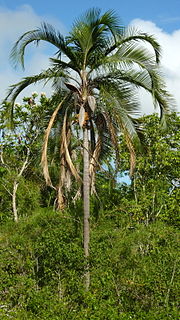
Syagrus is a genus of Arecaceae (palms), native to South America, with one species endemic to the Lesser Antilles. The genus is closely related to the Cocos, or coconut genus, and many Syagrus species produce edible seeds similar to the coconut.

Syagrus romanzoffiana, the queen palm or cocos palm, is a palm native to South America, introduced throughout the world as a popular ornamental garden tree. S. romanzoffiana is a medium-sized palm, quickly reaching maturity at a height of up to 15 m (49 ft) tall, with pinnate leaves having as many as 494 pinnae (leaflets), although more typically around 300, each pinna being around 50 centimetres (18 in) in length and 3–5 centimetres (1–2 in) in width.

Syagrus coronata, commonly known as the ouricury palm, aricuri palm, or licuri palm, is a species of palm tree that plays an important role in the diets of tropical seasonally dry forest animals. It is native to eastern Brazil, ranging from the southern part of the state of Pernambuco, into the state of Bahia, south to the Jequitinhonha River in the state of Minas Gerais. It can live for 30-150 years, however most only live for 8-10 years on average.

The dusky-legged guan is a species of bird in the family Cracidae, the chachalacas, guans, and curassows. It is found in Uruguay, northeastern Argentina and southernmost areas of Paraguay and Brazil. In early 2021, the former subspecies P. o. bridgesi, found in southwestern Bolivia and northwestern Argentina, was elevated to species rank as Yungas guan.

Butia eriospatha is a small species of Butia palm endemic to the highlands of southern Brazil. It is very similar to B. odorata, but is easily distinguished from this species by the distinct spathes which are densely covered in rust-coloured, woolly hairs. Indeed, the specific epithet is derived from Greek ἔριον, wool, and Latin spatha, which refers to the spathe. It has been given the name woolly jelly palm (UK) or wooly jelly palm (US) in English. Vernacular names for it where it is native are butiá-da-serra, butiázeiro, butiá-veludo, butiábutiá verdadeiro, butiá-do-campo, yatáy and macumá.

Syagrus botryophora is a species of flowering plant in the family Arecaceae. It is found only in Brazil. It is threatened by habitat loss.

Syagrus glaucescens is a species of flowering plant in the family Arecaceae. It is endemic to Minas Gerais state in southeastern Brazil. Its small population is threatened by collecting and habitat destruction.
Syagrus macrocarpa is a rare species of palm found only as scattered isolated individuals and small groups in the east of the Brazilian states of Espírito Santo, Minas Gerais and Rio de Janeiro. It grows to 4-10m tall, with 8-20 leaves to 2m long. The leaves are bent at the end, with very hairy margins near the trunk, and consist of 180-320 slightly coiled leaflets irregularly arranged in several planes on the rake. The fruit are oval, greenish-yellow, 6–9 cm long. It is grown in cultivation. Seeds are difficult to germinate, with low rates of germination. Common names for it in Minas Gerais are baba-de-boi-grande and maria-rosa.

Syagrus pseudococos is a species of flowering plant in the family Arecaceae. It is found in tropical rainforest and on rocky outcrops in eastern Brazil along a coastal strip from extreme south of state of Bahia south through Espírito Santo, Rio de Janeiro to São Paulo.
Syagrus ruschiana is a species of flowering plant in the family Arecaceae. It is found only in Brazil.
Syagrus smithii is a species of palm tree found in Brazil, Colombia, Ecuador and Peru.
Syagrus stratincola is a species of flowering plant in the family Arecaceae. It is found in French Guiana, Guyana, and Suriname. It is threatened by habitat loss.
Beauprea congesta is a species of plant in the family Proteaceae. It is endemic to New Caledonia.
Helicia albiflora is a species of plant in the family Proteaceae. It is endemic to Papua New Guinea. It is threatened by habitat loss.
Helicia amplifolia is a species of plant in the family Proteaceae. It is endemic to Papua New Guinea. It is threatened by habitat loss.

Syagrus cearensis is a natural palm endemic to Brazil.
Syagrus is a genus of leaf beetles in the subfamily Eumolpinae. They are known from the mainland of Africa as well as Madagascar. They are often attracted by plants in the family Malvaceae; Syagrus rugifrons and Syagrus calcaratus are pests of cotton. The larvae of Syagrus calcaratus attack the roots of the plant and cause it to wilt.
Amblynetes is a genus of leaf beetles in the subfamily Eumolpinae. It contains only one species, Amblynetes bottegoi. It is known from East Africa.

Butia campicola is a very small species of Butia palm with an underground trunk; native to the cerrados of central Paraguay and south-central Brazil.
Syagrus rupicola is a short species belonging to the palm family (Arecaceae), found only in Brazil, and was first described by Larry Noblick and Harri Lorenzi in 2010.










